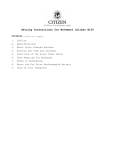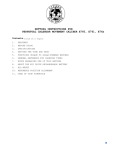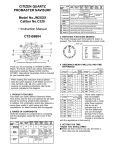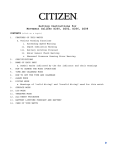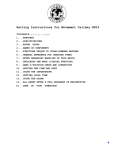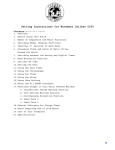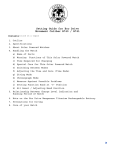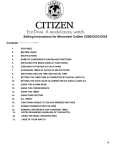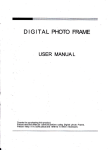Download Citizen B876 Specifications
Transcript
Setting Instructions for Movement Caliber B876 Contents (click on a topic) 1. 2. 3. 4. OUTLINE SPECIFICATIONS USE OF THIS WATCH A. ABOUT SOLAR POWERED WATCHES B. SETTING THE TIME AND DATE C. USING THE DUAL TIME FEATURE D. FUNCTIONS OF THE SOLAR POWERED WATCH E. TIME REQUIRED FOR RECHARGING F. LOW CHARGE AND TIME SET WARNINGS G. NOTES ON RECHARGING H. NOTES ON THE ECO DRIVE RECHARGEABLE POWER CELL I. USING THE ROTATING BEZEL TO DETERMINE TIME DIFFERENCES CARE OF YOUR WATCH Return to Table of Contents 1. OUTLINE This is a solar powered watch in which a solar panel is used to convert light to electrical energy. The dual time function of this watch indicates two different times by correcting the hour hand independently of the minute hand. 2. SPECIFICATIONS Movement Caliber Number B876 Type Analog Solar Powered Watch Accuracy +/15 seconds/ month At normal operating temp. o o o o (5 c –35 c) (41 f –95 f) Operation Temperature Range (-10oc –60oc) (14o f –140o f) Display Functions Time: Hours (local time hours), Minutes, Seconds, 24-hour indicator Calendar: Date Additional Functions x x x Insufficient charge warning Quick Start from low power state Time Setting Warning x From Full Charge to Stop: Approx. 6 months From two Second Interval movement to stop: Approximately 3 days Continuous Operating Time x Power Cell Eco-Drive Rechargeable Power Cell (not user replaceable.) Life of Power Cell Expected life is approximately 18-20 years. *note: specifications are subject to change without notice. Return to Table of Contents Return to Table of Contents 3. USE OF THIS WATCH A) About Solar Power This watch does not use a conventional battery, but an Eco Drive rechargeable energy cell. It is powered by light that is converted to electricity through a solar panel under the translucent dial. The Eco Drive rechargeable power cell is a clean energy unit that does not use any toxic substances. Once fully charged, the watch will continue to run for about 6 months without further charging. However, it is recommended that the watch be exposed to light every day to ensure that maximum performance is achieved. There is no need to be concerned about over-charging as there is a built in Over-Charge prevention feature. B) Setting the Time and Date If the crown is of the screw down type, be sure to unscrew the crown from the case before setting the time. After setting the time, be sure to screw the crown back to the case. <Setting the Time> 1. Pull the crown out to the time correction position, two clicks out (The second hand stops when the crown is pulled out to this position. 2. Turn the crown to set then 24-hour hand and the minute hand to the current time in your location. At this time, the movement of the hour hand is linked with the movement of the 24-hour hand. 3. Push the crown back in to the normal position. (the second hand begins normal movement once the crown is pushed in) 4. Pull the crown out to the date correction position (1 “click” out) 5. Turn the crown to the right (clockwise) and set the hour hand to the current local time. Be sure to pay special attention to AM and PM as the location of the hour hand where the date changes is approximately 12:00 AM Midnight. 6. Return the crown to the normal position next to the case. <Setting the Date> 1. Pull the crown out to the date correction position (1-click out) 2. Turn the crown to the left (counter-clockwise) and set the date. 3. Securely return the crown to the normal position Since the date is linked to the movement of the hour hand, the date starts to change when the hour hand approaches 12:00 AM Midnight. Please note this when using the dual time feature. DO NOT attempt to change or set the date when the hour hand is between 9:00 pm and 1:00 am. Setting the calendar when the hour hand is in this position may cause damage to the movement, and may result in improper operation of the date feature. Return to Table of Contents Return to Table of Contents C. Using the Dual Time Feature This watch allows the hour hand to be set independently of the minute hand, without stopping the watch. It ca be used as a dual time watch by setting the 24-hour hand and hour hand to different times. After correcting the time, the hour hand is used to indicate the “local time hours”. <Correcting the Local Time Hours> 1. Pull the crown out to the local time correction position (1-click out) 2. Turn the crown to the right (clockwise) and set the hour hand to the desired time. The hour hand can be adjusted in increments of 1 hour in the clockwise direction only. Be careful to pay attention to the AM and PM time as the date could be changed when passing 12:00AM midnight NOTE: The hour hand cannot be corrected in the Counter-Clockwise direction. As the calendar is linked by gears to the operation of the hour hand, it may be necessary to correct the calendar after correcting the hour hand, depending on which hour the hour hand was set to. 3. Securely return the crown to the normal position D. Functions of the solar powered watch If the charge becomes insufficient to power the watch, a warning function will operate and the display changes as indicated below: Return to Table of Contents Return to Table of Contents Insufficient Charge Warning Feature The second hand changes to a two second interval movement to indicate an insufficient charge state. When the watch first enters this state, it will continue to run and keep accurate time for up to 3 days before stopping. It is recommended that the watch be exposed to light regularly to avoid the watch stopping due to an insufficient charge. After exposing the watch to light, recharging takes place and the watch returns to one-second interval movement after a full recharge. Quick Start Function The watch will stop if the power cell becomes completely discharged. It will be start to operate after a short exposure to light. However, a full recharge will be necessary to obtain proper operation. Time Setting Warning Function If the watch stops, subsequent exposure to light allows the quick start function to start the watch. The second hand will move with a “hitch” to indicate the time needs to be set. In this case, fully recharge the watch and then set the time. Even if the Eco Drive Power Cell is fully recharged, the “hitch” movement will continue unless the time is reset and the crown is returned to the normal position. Over-Charging Prevention Feature Once the Eco Drive Power Cell is fully charged, the over-charge prevention feature initiates and prevents over-charging. Return to Table of Contents Return to Table of Contents E. TIME REQUIRED FOR RECHARGING Time required for recharge may vary according to the design (color and features) of the dial, and operating environment. Additionally, if the crystal becomes very scratched, it may not allow sufficient light to the dial. The following table will serve as a recharge guideline. Note: recharge time is the time the watch is continuously exposed to light. Running Time At Full Charge Low Charge Warning Quick Start Feature 180 Days 3 Days Yes Charge Rates from Indoor Light Source Indoors, Office (500 lux) One Day Use 1.5 Hours One Second Full Step Charge 22 Hours 320 Hours Charge Rates from Outdoor Light Source Outdoors Cloudy (10,000 lux) One Day One Second Full Use Step Charge 5 Minutes 1 hours 17 Hours Fluorescent at 6" Distance Incandescent at 20" Distance (3000 lux) One Day One Second Full Use Step Charge 19 Minutes 6.5 Hours 22 hours Outdoors Bright Sun (100,000 lux) One Day One Second Use Step 2 Minutes 14 Minutes Full Charge 6 Hours F. LOW CHARGE WARNING When the charge level in the power cell reaches a low state, the second hand starts moving at two-second intervals to warn that the watch is in need of a full recharge. It will continue to operate in this state for approximately 3 days before stopping. When the happens, be sure to fully charge the watch by exposing it to light as indicated in the chart above. When the watch is fully charged, the second hand will return to normal operation. two-second interval movement Time Setting Warning When the watch has stopped and is exposed to light, the second hand starts hitch movement. (quick start feature) The time elapsed before the second hand restarts moving depends on the type of light the watch is exposed to. Even after a full recharge, the second hand continues in a hitch movement to indicate the watch needs setting (time setting warning feature). When this happens, be sure to correct the time. If the watch is insufficiently charged, the second hand will soon return to two-second interval movement in order to warn further charging is necessary. hitch movement Return to Table of Contents Return to Table of Contents G. NOTES ON RECHARGING Be sure to regularly expose your Eco Drive watch to light every day for optimal performance. Please note that long sleeves can hide the watch from light and may cause the watch to become insufficiently charged. Avoid higho temperatures either during normal wear, storage or recharging, (above 140 F), as the watch and its sensitive components may become damaged. High temperature can be experienced from: x x x Charging the watch with a light bulb that is too close a proximity. Never get the watch closer than 24 inches to an incandescent bulb, and 6 inches to a fluorescent bulb. Never place the watch on the dashboard or rear deck of a vehicle. Very high temperatures can be experienced here. H. NOTES ON THE ECO DRIVE RECHARGEABLE POWER CELL This watch uses a power cell that does not need to be regularly replaced. Furthermore, it is not a user replaceable item. NEVER use any other type of battery, such as a silver oxide battery, in this watch. The over-charge prevention feature will not operate other than with the original type power cell. Use of any other type of power cell may result in the movement to burst, causing damage to the watch and even to the wearer. Return to Table of Contents Return to Table of Contents I. USING THE ROTATING BEZEL A rotating bezel is provided on some models. The rotating bezel contains the names of 23 cities arranged in order of time difference. Using this bezel makes it possible to read the times in 23 major cities around the world. 1. First check that the current time is correct for your location. 2. Turn the rotating bezel so that the city name at which the 24 hour hand has been set is alighted at the 24:00 position. The rotating bezel is normally used in this state. Example: When the 24 hour hand has been set to Paris, France time, align “PARIS” on the rotating bezel to the 24:00 position. *NOTE: The rotating bezel does not account for those time zones using “daylight savings” time. <Reading the Time of Other Cities> Turn the rotating bezel so that the city name at which the 24 hour hand has been set (example: Paris) is aligned as the position of the 24-hour hand. Read the time of another city by using the “24-hour scale” as a reference Example: When determining the time in Tokyo while in Paris, the 24-hour hand is assumed to be set at the time in Paris. 1. Alight “Paris” on the rotating bezel to the position of the 24-hour hand. 2. Read the “24-hour scale” at the “TOKYO” position on the rotating bezel. (Paris is 18:00 / Tokyo is 2:10 Return to Table of Contents Return to Table of Contents PRECAUTIONS ABOUT CARE AND HANDLING OF WATCHES TEMPERATURE CARE Avoid temperature extremes. Exposing your watch to high temperatures, such as placing it on the dashboard of a vehicle or use in a hot tub, may cause the watch to malfunction, shorten battery life or damage certain components. Leaving the watch in extreme cold temperatures may cause irregular timekeeping until the watch returns to normal operating temperature. SHOCK-RESISTANT The watch may be worn while playing golf or other activities, but avoid severe shocks such as dropping it on a hard surface. MAGNETIC-RESISTANT No problem should occur from using the watch around ordinary household electric appliances such as TV sets or stereos. Keep away from magnets. CHEMICAL/GAS RESISTANT Do not expose the watch to chemicals or gases for long periods. WATCH CLEANING Stains, waterspots and accumulated dirt on the case, crystal or band should be removed with a soft cloth to prevent damage and premature wear. HANDLING OF WATER-RESISTANT WATCHES Although water-resistant watches are warranted, steps should be taken to avoid damage that may result from accidents or mishandling: ■ Do not operate the crown or push-button in the water or while the watch is wet. Tighten screw lock crown completely. ■ Should the watch become immersed in water, dry it off right away. If the watch comes in contact with salt water, be sure to rinse it thoroughly in warm fresh water to remove any trace of salt. ■ If a watch is wet from cleaning or by accident, never store it in a closed container. It should be dried immediately or taken to a watchmaker or jeweler if moisture is inside the case to prevent damage from rust. ■ Vital components necessary to resist the entrance of moisture deteriorate with time and use. Gaskets, crowns and other materials should be replaced every year or two to ensure Marking on the Dial Marking on the Caseback that water resistant quality remains at factory specifications. CARE FOR METAL BRACELETS To extend the life and maintain the good appearance of the metal watch bracelet, the following recommendations are given: ■ Be aware that since the watch and bracelet is worn next to the skin, it collects dust and perspiration and becomes soiled if not cleaned regularly. This is particularly true of the inner parts of the links or mesh of the bracelet. ■ Soil and rust, when present in a bracelet, are dissolved by perspiration and can cause staining of cuffs and irritation of the skin in some instances. ■ Heavy perspiration should be wiped off the watch and bracelet with a soft dry cloth. The bracelet should be cleaned occasionally by using an old toothbrush and warm soapy water after which the soap is thoroughly rinsed with clear water and the bracelet dried completely. The foregoing manner of cleaning should not be done if the watch is not water-resistant but should instead be done by your jeweler. CARE FOR STRAPS LEATHER ■ Heavy perspiration, if not removed from a leather strap, can wash out the natural oils and cause the leather to become dry and deteriorate. Any moisture should be blotted with a soft dry cloth or paper towel and the strap allowed to dry naturally. ■ Salt residue and soil can be removed from the leather by cleaning with a dampened soft cloth and mild soap or saddle soap. ■ Occasionally, the inside surface of the strap should be cleaned by using a soft cloth dampened with alcohol. ■ The strap should always be worn a little loosely (one finger space between wrist and strap) to allow air to circulate thus causing any moisture to evaporate. RUBBER ■ Rubber straps should be washed frequently with mild soap and warm water using a soft brush. ■ Thorough cleaning, using the same method, should especially be done after use in salt water. ■ Solvents, oils, perspiration, tanning lotion and salt can cause rubber to deteriorate if not removed. Water-resistant characteristics Face washing, splashes, sweat, raindrops, etc. Swimming Skin diving (diving without air tanks) Scuba diving (diving with air tanks) Non water-resistant watch and must be kept away from water. NONE NONE NO NO NO NO NONE WATER RESIST OK NO NO NO WR100M WR10bar WR150M WATER RESIST OK OK OK NO For frequent use with water. It is not specially designed for scuba diving. WR200M WATER RESIST OK OK OK OK For skin and scuba diving. Usable up to the respective indicated depths. An ordinary water-resistant watch and can withstand splashes, sweat, rain-drops and etc. for daily life use. Return to Table of Contents Return to Table of Contents Water Resistance The water-resistant quality of our timepieces is offered in varying degrees depending on the model. This ranges from non-water resistant models to those suitable for SCUBA diving. Water resistance of our timepieces is measured in BAR or Barometric Pressure. Each BAR of pressure is equal to 14.5 pounds per square inch of pressure. Water resistance is measured when the watch is at a static, or motionless state. As the watch is moved in water, such as from the motion of swimming, pressure is added from velocity. While you may be swimming in a pool at surface level, the watch may be experiencing forces equal to that of 100 feet of water pressure (3 BAR). Diving into a pool can cause forces on the watch to exceed those pressures. As such, you should always allow a margin of safety when exposing your watch to moisture. Never "push the limit" of the degree of water resistance of your timepiece. A primary factor to keep in mind about water resistance is that periodic maintenance is needed to maintain original factory specifications for water resistance. When a watch is new, it meets specifications for water resistance as indicated on the case back. However, as the watch ages, the gaskets that seal the watch become dry and brittle, diminishing its water resistant quality. Exposure to environments such as chlorinated pools, salt water or soaps from showering can accelerate drying of the gaskets. We recommend that the gaskets be changed at least every 18 to 24 months to maintain the water resistant quality of your timepiece. If the watch is frequently exposed to chlorinated pools, soaps salt water, etc., we recommend that the gaskets be changed on a yearly basis. From time to time, you may notice condensation that appears then goes away after a short period of time. This is a normal occurrence and happens primarily from sudden temperature changes. When there are sudden temperature changes such as entering a cool building from the hot out of doors, or jumping into pool on a hot day the watch may fog. Conversely, if you go to the cold outdoors from a warm building, fogging may occur. As long as the fogging clears in a short period of time, there is no need for concern. Be sure the crown is completely pushed in prior to any contact with moisture. If your model is equipped with a screw down crown, be sure it is properly seated against the case. Do not operate the crown or any push button when the watch is wet as this may allow the entrance of moisture. . If at anytime, you notice moisture in your timepiece that does not clear in a short period of time, you should send your timepiece as soon as possible to the nearest Authorized Service Center for inspection. You can determine the level of water resistance of our watches from the markings on your case-back. Additionally, models that are water resistant to 100 or 200 meters have an indication on the dial as well. The case-backs and dials are normally marked as follows: The case back has no indication of water resistance This indicates the watch is a non water-resistant model and is not designed for contact with moisture at all. Caution should be exercised to avoid any contact with moisture, such as when washing your hands or from a rainstorm. “Water Resist” This watch is designed to withstand water from accidental splashing, such as from washing your hands or rain. Any submersion into water may result in the entrance of moisture. “Water Resist 10BAR” or “W.R. 10BAR”, Dial marked “WR100” This watch is designed to withstand water pressure up to 333 feet. This includes water exposure from accidental splashing and rain, but also from showering, swimming in a pool and snorkeling. Be sure to rinse the watch with fresh water after exposure to a chlorinated pool, salt water, soaps, etc. After rinsing with fresh water, be sure to dry the exterior with a soft cloth. “Water Resist 20BAR” or “W.R. 20BAR”, Dial marked “WR200” This watch is designed to withstand water pressure up to 666 feet. This includes all exposure to water up to and including recreational SCUBA diving. Be sure to rinse the watch with fresh water after exposure to a chlorinated pool, salt water, soaps, etc. After rinsing with fresh water, be sure to dry the exterior with a soft cloth. Special Note about Jacuzzis and Hot Tubs The various components used in the manufacture and assembly of your watch expand at various rates. This results in a loss of the sealing capabilities of gaskets, which may allow moisture to enter. In addition, heat from these sources can cause deformation of certain materials leading to mechanical failures. For these reasons, you should remove your watch before entering a hot tub or Jacuzzi. Return to Table of Contents










